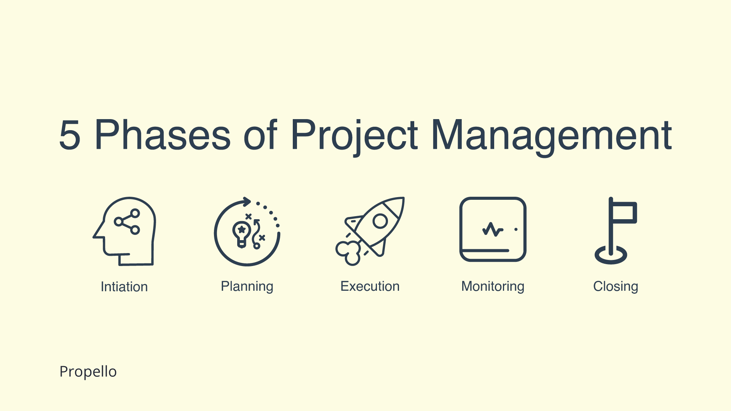Managing a project can be a daunting task, especially if you are new to project management. Are you feeling overwhelmed and unsure of where to start? Don't worry, we've got you covered.
Our Research shows, 39% of projects fail due to a lack of planning, inadequate resources, and insufficient work activities.
Project management is a crucial skill in today's fast-paced and competitive business world. Whether you are leading a small team or overseeing a large-scale project, effective project management is essential for success.
However, many people struggle with the complexities and challenges that come with managing a project.
If you want to ensure the success of your project, you need to have a clear plan, strong leadership skills, and the ability to adapt to unexpected challenges. Managing a project requires a combination of organization, communication, and problem-solving skills.
In this article, we will discuss some key strategies and best practices that will help you effectively manage your project from start to finish.
|
Project Management Project management is the systematic approach of planning, executing, and controlling tasks, resources, and timelines to achieve specific objectives within a defined scope. |
What is Project Management?
Project management is the structured and organized approach to planning, executing, monitoring, and closing tasks and activities within a specified timeframe to achieve well-defined goals. It's a strategic process that involves coordinating resources, managing risks, and ensuring effective communication to accomplish projects.
From small tasks to complex endeavors, project management provides a framework for turning ideas into reality while maintaining control over various variables.
At its core, project management encompasses a set of principles, techniques, and tools that help guide a project from its initiation to its completion. It involves defining project objectives, breaking down tasks, assigning responsibilities, setting deadlines, and continuously tracking progress.
Project management isn't limited to a specific industry or field; it's a versatile approach applicable to business, construction, technology, marketing, and more.
In essence, project management ensures that projects are completed efficiently, on time, and within the allocated budget. It empowers teams to collaborate effectively, adapt to changes, and deliver quality outcomes.
The practice of project management is crucial for organizations aiming to achieve their strategic objectives, enhance productivity, and maintain a competitive edge in the ever-evolving business landscape.
The Project Management Process
The first step in any project is the process. The process defines how you will get from point A to point B. This includes defining what needs to be done, who will do it, when it will happen, and how it will be measured.
To be successful in the world of project management, you need to know what your process looks like. This process has four phases: initiation, planning, execution, and completion.

1. Initiating
As with any good project, there are some things you must do before beginning a project. These initial steps are crucial to creating a solid foundation upon which to build your project.
Project scope: The specific limits and boundaries for the projects. It includes what will be accomplished in this particular task and what won't (i.e. objective here).
High-level project overview: It takes into consideration the resources, timing, and goals involved in completing a project. It includes a method for monitoring these requirements over the course of the project.
Budgets: How large is the budget required for success?
A project charter or "Project Initiation Documentation" (PID) may be created for larger-scale initiatives.
2. Planning
To be sure, during this stage, key milestones and dates need to be set, including the final deadline for the final deliverable. By setting clear and intentional deadlines, you can help avoid any confusion later on when you encounter obstacles. This will also save time and energy by avoiding unnecessary delays.
To be successful at this stage, you need to understand which techniques the team will use. You could choose from Agile, Waterfall, PRINCE2, Scrum, Lean, and Kanban. Get more detail in our project management guide.
The planning phase also includes:
- Selecting the team members
- Outlining deliverables
- Estimating resources
- Determining associated activities
3. Executing
Execution is about completing what we planned to do during the planning stage. We execute our plans by doing it. If we don't execute, we're wasting resources and missing opportunities.
Execution requires focus, discipline, and accountability. No plan is perfect that is why managing workflows and constantly making needed changes is important for project success.
Managing workflow means managing how things happen within the teams or organizations. This includes making sure people are working together effectively, and ensuring that work gets done efficiently. Managing workflow is about getting tasks completed in the most effective way possible.
Making needed changes means suggesting an alternative course of action, based on current conditions. Sometimes we need to recommend a change because something isn't working well enough.
Other times, we recommend a change because we think there might be a better option out there.
4. Monitoring/Controlling
Monitoring and controlling are essential parts of any successful project. A project manager needs to know how much work is left to do, how far along it is, and whether it's on schedule.
To make sure everything goes smoothly, a good project manager must be able to see where things stand at any given moment. This requires regular monitoring and control.
Proper use of project documentation and tracking tools or frameworks, including task management systems, Kanban boards, Gantt charts, and daily meetings. The more visual and real-time this is, the easier it is to communicate it to key players, and the easier it is to adjust.
5. Closing
Closing is usually the final step in a project. It’s typically the last step before a project is completed. It’s a good time to review what went well and improve upon it.
You might also want to look ahead to future projects and decide how you will approach them differently.
4 Frameworks to guide project management
Choosing a framework for your project management system is one of the most important decisions you'll make when planning your project.
The following four frameworks provide some guidance on how to approach managing a project. Each one offers different ways to manage tasks, assign responsibilities, track progress, and communicate effectively.
Some offer additional features that might help you build better software.
1. Waterfall project management
Waterfall or Traditional project management focuses on perfecting the plan before starting the project. You first figure out exactly what needs to be done, and then you set up a timeline for completing each task.
The waterfall is a rigid process where requirements are defined upfront, development begins, testing follows, and deployment completes the cycle.
This method works well for large projects that require a lot of planning. But for smaller projects, waterfall often leads to over-specification and missed deadlines.
2. Kanban project management
Unlike the Waterfall method, which focuses on completing tasks one at a time, Kanban projects focus on continuous improvement. A Kanban board helps teams plan how they're going to improve their products, campaigns, or services.
Kanban is a flexible methodology that uses visual tools to keep work flowing smoothly. Kanban helps teams deliver value quickly while maintaining quality.
With Kanban, you start with a backlog of user stories (or other types of work). As new items come into the queue, they move through several stages: Incoming inspection, Backlog refinement, Definition, Development, Testing, and Deployment.
This allows you to prioritize which items should get worked on first and gives you visibility into the status of all the items in the pipeline.
3. Scrum project management
Scrum is an agile method that's based on the idea that people who have been working together for years know best how to collaborate.
Teams follow a series of steps to develop their product: Sprint Planning, Daily Standup, Refinement, Iteration, and Release. It breaks large projects down into smaller ones that can be completed within 4 weeks.
Scrum has become popular because it provides structure and accountability for teams. It also keeps everyone focused on delivering value to customers.
However, Scrum doesn't address many issues that arise during the course of a project.
For example, if you find yourself stuck on a problem, there isn't much you can do about it. If you want to change something, you'll have to go back to your team and ask them to make changes.
4. Agile project management
Agile project management emphasizes flexibility over perfectionism. Instead of defining every detail of a project upfront, agile methods focus on building a prototype or proof of concept. Then, as you learn from users and stakeholders, you can iterate and refine the product.
This method encourages collaboration between developers and business owners. It also makes it easy to add new functionality without breaking existing code.
However, agile methods don't always lead to high-quality products. They're not suitable for complex projects that need lots of planning.
Agile is best suited for Growth-Driven Design projects.
How can you build a productive project team?
Your framework and the scope of the projects you're working on will determine how you organize your team. These are some proven ways to help create a successful and productive team.
1. Hire people from different departments
You may need to bring together people from different departments for your project because they each offer unique skills and perspectives.
You don't need to hire new people; instead, you can use existing employees and combine their skill sets into one project. For example, if you're launching a new marketing campaign, you might want to bring together web developers, graphic artists, and content writers.
2. Choose a project manager carefully and define their roles clearly
Project managers could be either professional project managers or subject matter experts (SMEs). SMEs are people who are extremely knowledgeable in the area of the job. Here we can identify who typically wears the project management hat.
A professional project manager (PM) may be involved in more of an advisory role during initial planning. Stakeholders and SMEs get involved in shaping the project plan by using their own experiences.
Smaller projects usually don't have enough budget for a full-time project manager position so they might hire one part-time or use an SME or executive instead.
What does a project manager do?
Project managers may vary depending on the company, but they're typically responsible for managing the daily operations of a project and its staff. They must also manage aspects of a project:
- Scope
- Schedule
- Finance
- Risk
- Quality
- Resources
3. Make sure everyone knows they're expected to do
If the project manager has to babysit every single team member and makes the final call on every small detail, the whole thing will move slowly. Instead, give your team members the freedom to decide for themselves and let them take action.
4. Don't micromanage
Managers who micro-manage their teams slow them down and hurt their productivity. Instead, managers should encourage their teams to take ownership of tasks and provide full transparency of what's expected from each member of the group.
10 effective tips on how to manage a project
A project manager must know what he/she wants and why it matters. This article offers 10 tips on how to manage projects effectively.
1. Define Project Scope
Your project scope defines the boundaries within which you are working. You need to know what you want to achieve, how long it will take, and what resources you'll need to complete it.
This allows you to plan and avoid wasting time and money on projects that aren't successful. If you're unsure about whether you've set the correct scope, ask yourself questions like:
- What do I want my project to look like?
- How long will it take me to complete it?
- Will I use software tools, hardware devices, or both?
- Do I need to hire additional people?
- Is there anything else I should consider?
2. Know your timeline
Project timelines are important to know what stage you're in along the way. If you don't know where you stand, you won't know whether you've met your deadline.
Your project deadlines should be set earlier than you think you'll need them. This gives you room to make adjustments if something unexpected happens.
You must keep track of all the tasks assigned to the project during its duration. If you forget about one task, it could delay the entire project.
3. Assess your available resources
Before starting any new project, you should assess your current resources. It is not always possible to add more people to a project without increasing costs. However, you can often reduce the number of hours worked per week by reducing the amount of work done.
It is also worth considering outsourcing some of the work. Outsourcing means hiring someone else to perform certain tasks. This frees up your time to focus on other areas of the project.
4. Create a project plan
Get feedback from top management and key stakeholders about the project scope and timeline. You'll use an agile methodology to manage the project and track progress.
Finally, you'll create a network diagram to visualize the interactions among stakeholders throughout the project lifecycle. This exercise helps ensure that everyone involved understands what needs to happen next and where the project stands.
5. Communicate with the team
Meetings are important for any successful project. You want to make sure everyone knows about upcoming deadlines, changes, and deliverables. But how do you ensure that everyone is aware of everything happening around the office?
Communication is key to keeping projects moving forward.
If you don't communicate well, it becomes hard to keep everyone on task. If you're communicating poorly, it could lead to confusion and miscommunication.
6. Delegate Work According to Available Resources
Delegating work to others is one of the best ways to save time and improve efficiency. You can use delegation to handle tasks like writing articles, creating presentations, managing social media accounts, etc.
When delegating work, it is important to consider what resources are available to complete the task.
For example, if you want to write an article, you might ask yourself whether there is enough time to do it, whether you have access to the necessary software, etc. If there are no resources available, you will have to decide whether the task is worth doing.
There are different types of delegations, depending on how much control over the project you give to the person who will carry out the task. In some cases, you can even choose to make the decision yourself.
For instance, you could let another person take care of the social media account of your brand, while you focus on other aspects of the business. Or you could hire someone to help you write a report about your product.
You can also delegate certain tasks to people who specialize in those areas. This makes sense because they know exactly what needs to be done.
7. Document Everything!
Documentation is one of those things that most people do without thinking about it. But documenting everything helps you review your projects before the final product release, ensuring that you don't miss anything important.
It's easy to forget something when working on a project. So having documentation ready beforehand saves you time and energy later on.
And keeping all records of your project — including screenshots, mockups, wireframes, design comps, prototypes, etc. — ensures that you don't forget anything during the project execution.
8. Monitor the project progress
The most important thing about tracking metrics is having a plan. If you don't know what you want to achieve, how are you going to measure whether you're achieving it?
You'll never know if you've achieved anything unless you set yourself goals. This is why it's important to track your KPIs.
KPIs (key performance indicators) are numbers or measurements that show how your company is performing. They are used as a way to evaluate the success of your company.
9. Use Project Management Software
Project management software is essential for running a smooth-running team. It allows you to create schedules, assign tasks, monitor progress, and more.
If you're not using a tool like this yet, now is the perfect time to start. It will allow you to organize your workflow, streamline communication, and stay organized throughout the entire process.
10. Follow up and appreciate
If you're looking for a way to make sure your team is working toward common goals, consider following up with each person individually. This simple technique helps everyone understand where others are coming from and why they might think differently about something.
This approach encourages collaboration and builds trust among team members. And it shows them that their opinions matter.
So follow up with your team regularly and thank them for their contributions. This will encourage them to keep contributing.
Succeed with Project Management
In the dynamic landscape of business and innovation, effective project management is a cornerstone for success. Whether you're launching a new product, implementing a marketing campaign, or executing any complex endeavor, the principles of project management provide a roadmap to steer your efforts toward achievement.
Remember, successful project management isn't just about meeting deadlines and staying within budget. It's about fostering collaboration, leveraging resources wisely, mitigating risks, and delivering results that align with your organization's goals.
By adopting a structured approach to project management, you can ensure that your projects are executed smoothly, your teams are aligned, and your objectives are met.
At Fine Media, we comprehend the pivotal role of precise project management in driving marketing success. Let us be your strategic ally in realizing your marketing aspirations.
Our adept team specializes in steering marketing projects to triumph, guaranteeing impeccable execution, optimal resource allocation, and exceptional outcomes. Connect with us today to explore how we can elevate your marketing endeavors. Your triumph in the marketing arena is our ultimate objective.



